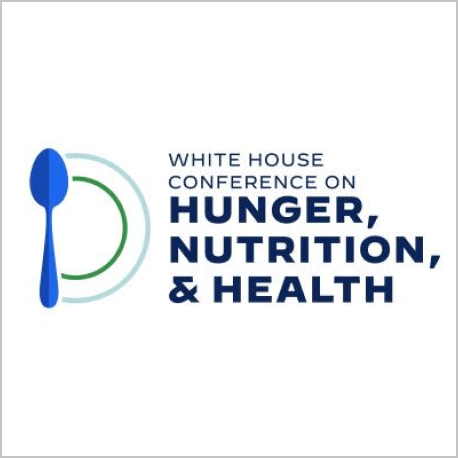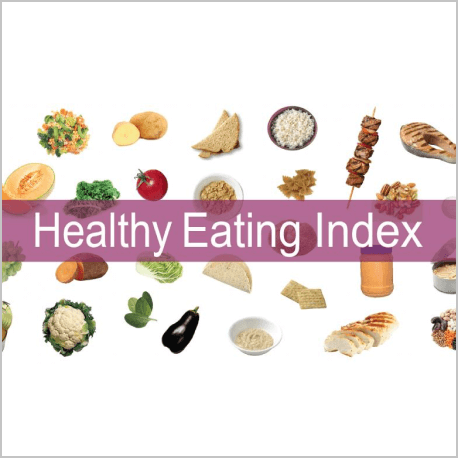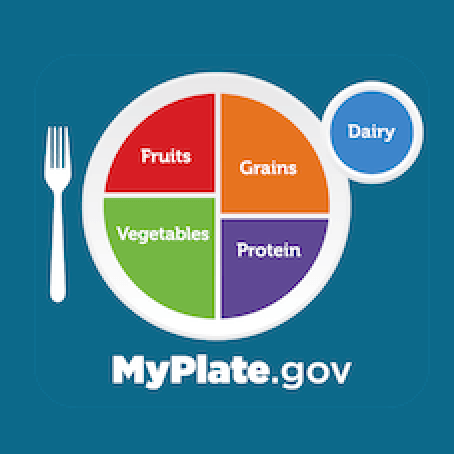Projects Related to the Dietary Guidelines
Updating the Dietary Guidelines for Americans (Dietary Guidelines) is a scientifically rigorous, multi-year process. Below are examples of Federal and non-Federal projects relevant to the Dietary Guidelines.

White House Conference on Hunger, Nutrition, and Health
For the first time in over 50 years, the White House hosted the White House Conference on Hunger, Nutrition, and Health on September 28, 2022. The Biden-Harris Administration also released a National Strategy outlining actions the Federal government will take to achieve the bold goal of ending hunger and increasing healthy eating and physical activity by 2030.
The Biden-Harris Administration also announced more than $8 billion in new commitments as part of the Conference's call to action.

Dietary Reference Intakes
Established by the National Academies of Sciences, Engineering, and Medicine (National Academies), the Dietary Reference Intakes (DRIs) provide reference values for vitamins, minerals, and other nutrients that: 1) indicate daily intake amounts that meet the needs of most healthy people, 2) set intake levels not to exceed to avoid harm, and 3) reduce the risk of chronic disease.
These reference values provide an important source of evidence for the Dietary Guidelines by helping to understand if the population is meeting or exceeding nutrient needs through the foods and beverages consumed.
The Dietary Guidelines uses the DRIs to make food-based recommendations that help Americans to meet their nutrient needs. The Dietary Guidelines includes in Appendix 1 nutritional goals for different age-sex groups, which are based on the DRI nutrient standards. These nutritional goals are also included in the USDA Dietary Patterns to ensure that the patterns are designed to meet nutrient needs of individuals across the lifespan.
The National Academies establishes DRIs for the United States and Canada. The U.S. and Canadian governments work together through the Joint U.S.-Canada DRI Working Group to determine which DRIs need to be updated and to sponsor the DRI development process. The DRI Working Group prioritized updating the energy and macronutrient DRIs. The review of the energy DRI is now complete. The macronutrient DRIs will be updated over the next few years with evidence reviews beginning soon on protein and carbohydrates.

Healthy Eating Index
The Healthy Eating Index (HEI) is a tool designed to evaluate how well a set of foods and beverages, such as the foods commonly consumed by Americans, aligns with dietary patterns recommendations from the Dietary Guidelines for Americans. The HEI-2020 aligns with the key recommendations from the Dietary Guidelines for Americans, 2020-2025 (for those ages 2 years and older). Additionally, a newly developed tool, the HEI-Toddlers-2020 assesses how well diets of toddlers (ages 12 through 23 months) align with the new recommendations for this life stage. The publication of the HEI-2020 and HEI-Toddlers-2020 can be found in the May 2023 issue of the Journal of the Academy of Nutrition and Dietetics.

MyPlate Consumer Education Resources
MyPlate helps consumers put the Dietary Guidelines for Americans into action with inspiration and simple ideas for making healthy choices across the food groups. Visit MyPlate.gov for a suite of nutrition education resources:
- MyPlate Tip Sheets: The tip sheets cover a variety of topics from food groups, healthy eating for different age groups, healthy eating on a budget, and so much more. All tip sheets are also available in Spanish. The Start Simple with MyPlate tip sheet is available in 20 additional languages.
- Life Stages: Find key recommendations from the Dietary Guidelines for Americans and supporting consumer resources.
- MyPlate Tools: Consumers can use these interactive tools to test their knowledge, get a food plan, set healthy eating goals, and more! Shop Simple with MyPlate is one example that empowers consumers with new ways to prepare budget-friendly foods and local SNAP savings. Find Spanish versions of many consumer resources at MiPlato en español.
- Toolkits for Professionals: Use these toolkits as you communicate MyPlate’s food and nutrition messages to your audiences. Health professionals can search by topic and access over 80 printable tip sheets through the Print Materials library.

Alcoholic Beverages and Health
Alcoholic beverages and health remain a high priority topic. HHS and USDA are addressing the scientific reviews on this topic through efforts separate from the 2025 Dietary Guidelines Advisory Committee. The scientific reviews on adult alcohol consumption and health are being conducted by a Department of Health and Human Services (HHS) Committee and the National Academies of Sciences, Engineering and Medicine (NASEM) working on complementary tracks. Both projects will include opportunities for public participation and will include external scientific peer review. These efforts are under way and slated to be completed by the end of December 2024. Each will result in a report with findings, not recommendations on alcohol consumption. These findings will be considered by HHS and USDA as the Departments develop the next edition of the Dietary Guidelines.
While both evidence reviews will address the relationship between alcohol and health, there are key distinctions between the two, including some of the outcomes being examined and the methods being used to conduct the studies. The table below provides a comparison of the two studies.
| Study | Purpose | Methods and Product |
|---|---|---|
| Interagency Coordinating Committee on the Prevention of Underage Drinking (ICCPUD) - Alcohol Intake and Health Study |
To generate evidence on weekly alcohol consumption thresholds to minimize health risks by modelling cause-specific absolute risk curves based on disease-, injury-, and condition-specific relative risk curves from cohort studies from conditions that are thought to be causally related to alcohol use (e.g., liver cirrhosis and cancer). This approach aligns with the current practices of the Centers for Disease Control and Prevention, the World Health Organization, and the Institute for Health Metrics and Evaluation, when estimating the burden of disease attributable to alcohol use. |
The alcohol intake and health study will use the following methods to generate evidence on weekly drinking thresholds to minimize health risks:
The ICCPUD study will provide findings on risk estimates, not recommendations for alcohol consumption. |
| NASEM - Review of Evidence on Alcohol and Health | To review, evaluate, and report on the current scientific evidence on the relationship between alcohol consumption and the following health outcomes:
|
The NASEM study involves the conduct of systematic reviews. The NASEM study will yield graded conclusion statements, not recommendations for adult alcohol consumption. |

Climate Change and Nutrition
Sustainability and the complex relationship between nutrition and climate change is an important, cross-cutting, and high priority topic. HHS and USDA have activities underway on this topic to inform work across the Departments.
For example, a newly launched NIH initiative, “Agriculture and Diet: Value Added for Nutrition, Translation, and Adaptation in a Global Ecology: ADVANTAGE,” is led by the Eunice Kennedy Shriver National Institute of Child Health and Human Development (NICHD). This work is focused on research and will examine evidence to better understand the intersection of food systems, diet, nutrition, and health in a changing environment. NICHD has supported similar initiatives on other topics.
Separately, USDA and HHS will convene a Federal Workgroup tasked with assessing the merits of various pathways to consider integrating sustainability into future editions of the Dietary Guidelines. The Workgroup will host public meetings intermittently to engage stakeholders. The Workgroup’s recommendations for approaches will be released publicly.

Physical Activity Guidelines for Americans
HHS develops the Physical Activity Guidelines for Americans which provides evidence-based advice on how physical activity can help promote health and reduce the risk of chronic disease. The second edition of the Physical Activity Guidelines for Americans includes recommendations for Americans ages 3 years and over — including people at increased risk of chronic disease.
It is an essential resource for health professionals and policy makers and is used to inform federal physical activity programs and initiatives. The Move Your Way® campaign is the promotional campaign for the second edition of the Physical Activity Guidelines for Americans. It offers tools and resources for consumers and professionals to learn about the Physical Activity Guidelines and share its key messages.
Recognizing the importance of physical activity to promote health and help prevent chronic disease, the Dietary Guidelines for Americans, 2020-2025 recommends that Americans of all ages meet the Physical Activity Guidelines for Americans.

Applying Systems Science in the Dietary Guidelines
In response to recommendations from the National Academies of Sciences, Engineering, and Medicine (NASEM), a report was developed with potential options to integrate systems science approaches into the Dietary Guidelines development processes, including implementation.
The report, Applicability of Systems Science Approaches to the Dietary Guidelines for Americans, leverages expertise from a diverse panel of systems science, nutrition, and health experts convened to discuss the topic. The report provides six action strategies for integrating systems science and highlights multiple opportunities across the nutrition landscape for how systems science could improve the implementation and impact of the Dietary Guidelines in achieving its public health goal of disease prevention and health promotion.
View the report and potential action strategies, including some already under way:

National Academies of Sciences, Engineering and Medicine Study: Process to Update the Dietary Guidelines
As directed by Congress, USDA commissioned the National Academies of Sciences, Engineering and Medicine to conduct independent studies on the process used to develop the Dietary Guidelines for Americans, which culminated in several reports for consideration by HHS and USDA as they continue to strengthen and evolve the process.
